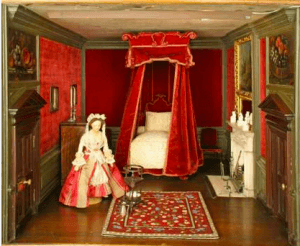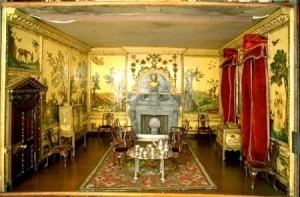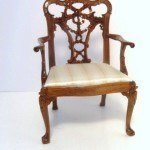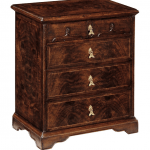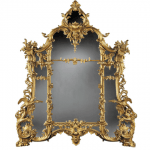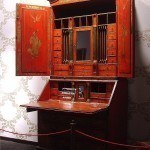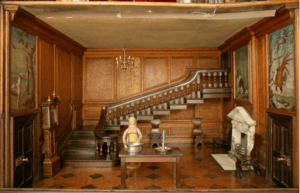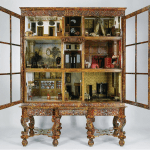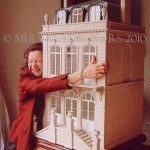
Front of the Doll’s House at Nostell Priory in Yorkshire, furniture attributed to Thomas Chippendale
‘Thomas Chippendale’ Dolls House
Thomas Chippendale was born in Yorkshire early in 1718. His family had long been in the woodworking trades and he probably received his basic training from his father. When his apprenticeship was completed, he moved to London and worked as a journeyman cabinet maker.
The Chippendale Shop
Chippendale was much more than a cabinet maker. He opened a shop across the street from a restaurant where aristocrats gathered to take high-tea. To draw attention to his wares, the sign above the door was usually a chair of his latest design, hung from the arm of a wall bracket. His business expanded to that of a modern-day interior designer, advising clients on all aspects of décor, such as soft furnishings and the color a room should be painted. At the peak of its success, the firm worked with other specialists who acted as sub-contractors, providing fully decorated and furnished rooms or whole houses, once the principal construction was done.
Chippendale often took on large-scale commissions from aristocratic clients. Twenty-six of these commissions have been identified.
It seems that Chippendale wanted to be remembered for his innovative creative ideas. In 1754 he published a book of his designs, entitled, The Gentleman & Cabinet Maker’s Director. It was published on a subscription basis to aristocrats and cabinet-makers. The shrewd publicity brought Chippendale many lucrative commissions. Three editions were popular with the gentry and cabinet makers who produced furniture in the “Chippendale manner.”
Three Chippendale Styles
Of particular interest to dolls house miniaturists are Chippendale design titles: Gothic, Rococo and Chinese. Chippendale blended these disparate stylistic elements into harmonious and unified designs.
Gothic
Chippendale incorporated pointed arches and S-shaped curves into the backs of chairs and, more successfully, in the glazing bars (wooden tracery holding the glass) and pediments of massive bookcases.
Rococo
Chippendale capitalized on the reaction against the heavy formality of Baroque furniture design. Many of the Rococo designs were French in origin, but Chippendale modified some of them for the less flamboyant English market. Among these are his French chairs based on Louis XV designs. Probably the best-known Chippendale design is a broad-seated ribbon back chair, with a back rail in the form of a cupid’s bow, and the pierced splat (center support in the back) composed of carved interlacing ribbons. The most elaborate Rococo designs, carved and gilded, were those for mirror frames, girandoles, and console tables.
Chinese
Chinese Chippendale designs in The Director were applied to china cabinets, or china shelves, which had glazing bars in a fretwork design and a pagoda-style pediment. Some pieces of Chinese Chippendale furniture, often intended for rooms decorated in chinoiserie, or Chinese style were japanned, or coated with oriental-style lacquer. This was popular in the Regency Period.

Ellie Matthews, Conservation Assistant, for the National Trust at Nostell Priory, preparing to clean the 6ft high 18th century dolls’ house.
Thomas Chippendale Dolls House
One of the most important commissions of Chippendale’s entire career was from Sir Rowland Winn of Nostell Priory, Yorkshire. The Doll’s House at Nostell is richly furnished in marble, silk, chintz, silver, walnut, mahogany, porcelain and glass. It is a treasury of craftsmanship and a unique record of daily life in a great country house of the period.
Whether Chippendale actually had anything to do with its creation is questionable. The National Trust catalogue listing begins with: ‘The Dolls’ House at Nostell Priory, attributed to Thomas Chippendale’. History buffs know when you see the word “attributed,” it’s buyer beware!
Who Cares?
This gorgeous dolls house contains almost all of its original furnishings, made by skilled craftsmen and faithfully presenting accurate miniatures in the Chippendale style. If you are traveling to Yorkshire, put the Nostell Priory on the itinerary.
I have included many links to the source material in this article.
Enjoy.
Susan Downing, with Patrick Owens


